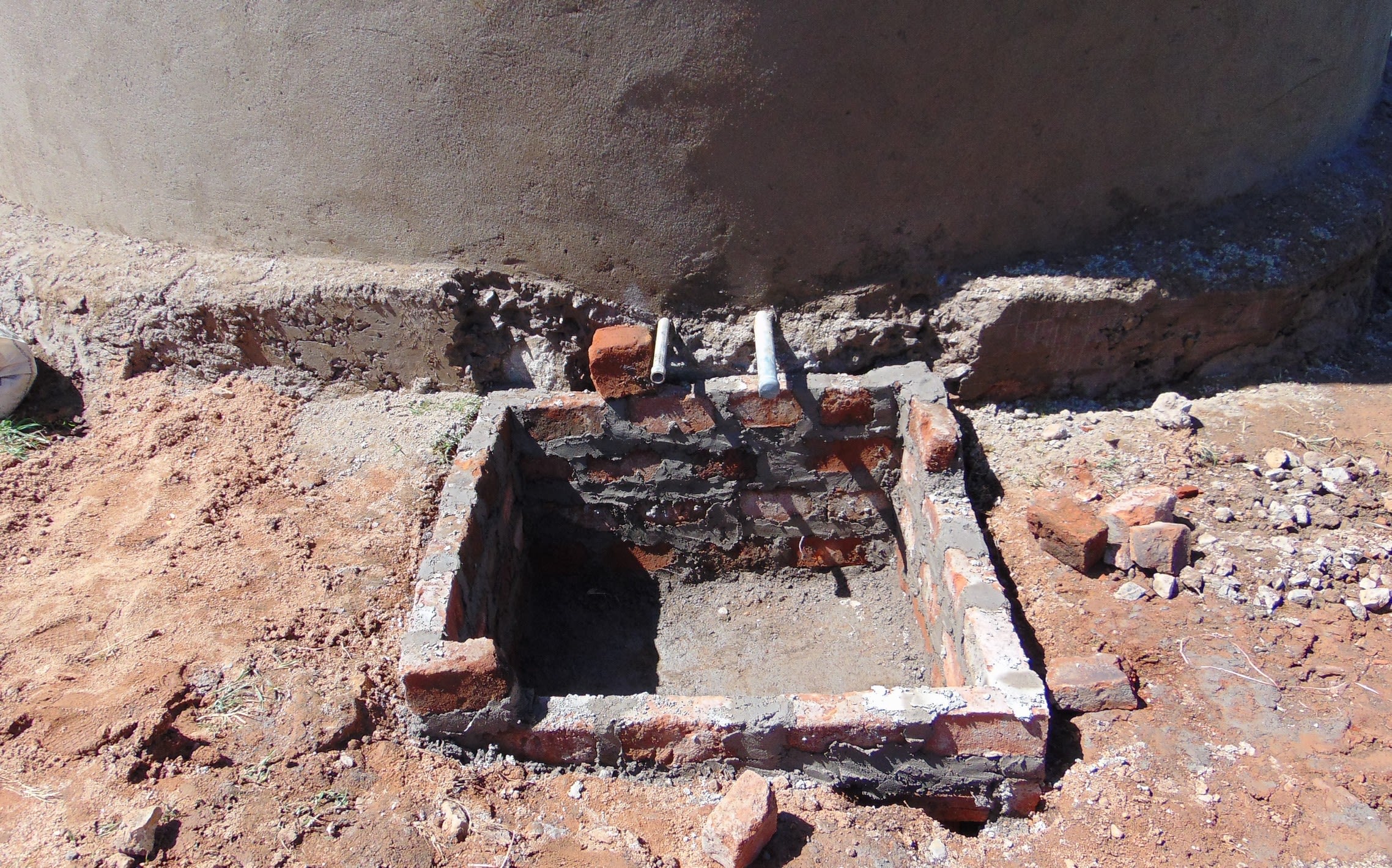November, 2019: Goibei Primary School Project Complete!
Goibei Primary School in Kenya now has access to a new source of safe, clean water thanks to the completion of their rain tank, which has the ability to collect 50,000 liters of water. We installed new latrines for students, handwashing stations, and we trained students and staff on improved sanitation and hygiene practices. All of these components work together to unlock the opportunity for these students to live better, healthier lives.

Student poses with the new rain tank
Rain Tank
Construction for this 50,000-liter rain tank was successful!
Parents, staff, and students helped our artisans gather everything needed for construction. All the while, the school cooks prepared meals for the artisans, and the school provided accommodations for the artisans during their work. Local women and men helped our artisans with their manual labor, too.
The process officially began with our staff and school administration looking around the school compound to try and determine the best location for a new rain tank. This needed to be the best site with good, clean roofing to catch the rainwater.

Tamping down concrete over the rain tank's foundation
Then, we cleared the site: excavating the soil within the required measurements to make level ground for the tank foundation. The foundation was cast by laying hardcore on level ground and then reinforcing it using steel, concrete and waterproof cement.

Cementing the rain tank walls from inside the tank
Both the drawing pipe as well as the washout pipe were affixed as the foundation was laid. The wall was built with ferro-cement techniques through 6 layers. The inner wall was plastered while rough casting was done on the outer part. Finally, the catchment area was dug, plastered, and a staircase installed.

Catchment area in progress
Dome construction could begin after the superstructure had been given enough time to settle. The manhole cover was fitted, inlet pipes were connected to the roof gutters, inlet screens, ventilation pipes (breathers) and overflow pipes were all done to standard.

Working on the dome
Once finished, the tank was given 3 to 4 weeks to undergo complete curing before it was cleaned and handed over to Goibei Primary School, though we will continue to offer them unmatchable support as a part of our monitoring and maintenance program. The celebration was a great chance for us to acknowledge the school administration and students as the primary parties entrusted with the tools we’ve given, as well as remind them of our continued support as they develop.

Students and staff pose with the new rain tank, holding their materials from training
After the training, the deputy head teacher, pupils, and the facilitators assembled at the tank. Thank you messages were received from everyone and this was a sign of appreciation of the good work done.
Madam Deputy Head Teacher Ella Sasita was very jovial and appreciative because the stress of pupils going to cross the road going to fetch water was an ended thing. The staff also thanked the teachers and even the pupils for the cooperation which made the implementation process smooth. This was crowned with prayers thanking God for the work done.
"The construction of this tank has really made us proud. As a school we are privileged to have our own [water] source without going to queue with the community members at a tap and also we will not have unsure water from pupils' homes," said Madam Deputy Sasita.
"This is a blessing to have just at the beginning of the new term. It will help us have enough time with pupils in class and also many will not [be burdended] with water as they carried it from home. From the main gate, you enter the school and the beautiful tank welcomes you and this increases thirst and you just want to get water to quench the thirst. Therefore we are very very grateful for the good work and we promise to take good care of it so that it can serve many more pupils that will be coming over the years," she said.
VIP Latrines
This project funded the installation of 6 new ventilated improved pit (VIP) latrines, half for girls and half for boys. All of these new latrines have cement floors that are designed to be easy to use and clean. And with a rain tank right on school property, there should be enough water to keep them clean.

Girls celebrate their new latrines
Handwashing Stations
The 2 handwashing stations were delivered to the school and handed over to the student health club. These were placed outside of the girls’ and boys’ latrines to encourage handwashing after latrine use.
Health club members teach other students how to properly wash their hands at the stations, make sure the stations are filled with water, and work to ensure that there is always soap or ash available.

Handwashing
New Knowledge
Hygiene and sanitation training was scheduled with the help of the school principal and Madam Deputy Head Teacher Ella Sasita, who together ensured that the training date would be convenient for students, staff, and parent representatives. Individual teachers helped by selecting students from each class to represent the others.
19 students attended training, which was held inside a classroom. The place was quiet and the concentration level was high for next to this classroom there were higher-level students doing their national exams, thus making the training run very smoothly. The participation from this group was on point, as the pupils were all sharp and when a question was asked, everyone raised their hands to be chosen to answer. All the participants showed interest in learning making the session interactive and lively.

Group discussion during training
We covered a number of topics, including personal hygiene such as bathing, oral hygiene, and handwashing with soap as a barrier from germs; and operation and maintenance of the new facilities, with each person understanding their role for long-lasting clean water and good health. The new student health club will be greatly involved in project management and will be responsible for encouraging good health and hygiene practices amongst their peers, teachers, and the larger community.

Trainer Laura Alulu leads the handwashing demonstration
Handwashing was a special topic that the pupils mastered well and promised to teach the rest of the school every month as a reminder on the 10 proper steps. The pupils were singing the 10 handwashing steps happily as they reminded each other how they were taught to do it, a clear indicator that they understood and retained well what they were trained on.
Another topic which was discussed at length was, of course, water. We talked about sources of water, storage, pollutants, treatment, and its importance both for general use and in our bodies. The pupils were so sharp and this made this topic interesting and easy to train. The effects of not having clean safe and sufficient water were also shared.

Trainer Jemmimah points out the guttering system along their schoolroom to the pupils while they learn about the rain tank
What made this topic special was one pupil who wanted to know where the water in the body goes when someone is sick because she had heard that some sick people need to get water added through their veins (as an IV). This was to her curiosity because she thought the IV fluids she had heard about were the same as regular drinking water. A great lesson many learned here was that if they can drink enough water daily, they would hopefully not find themselves in hospital suffering from dehydration due to water-related illnesses, especially diarrhea.
Overall this training group was very sharp and articulate. The pupils were good in coming up with activities they could do to make the group active and thereby attract other pupils to join. They mastered the many topics well, from hygiene and sanitation to the maintenance and management of the rain tank, latrines, and handwashing stations.
"The training has been so educative and from here [on] my lifestyle is changing for [I] am equipped with basic knowledge and understanding on what [I] am supposed to do to make it possible. The training came in a good time just after [the seasonal] opening [of] school and this will help us disburse the information to other pupils. Sharing information helps one to internalize [it] more and that is exactly what I will do," said 12-year-old student Lucy.
Thank you for making all of this possible!



 Rainwater Catchment
Rainwater Catchment
 Rehabilitation Project
Rehabilitation Project

































